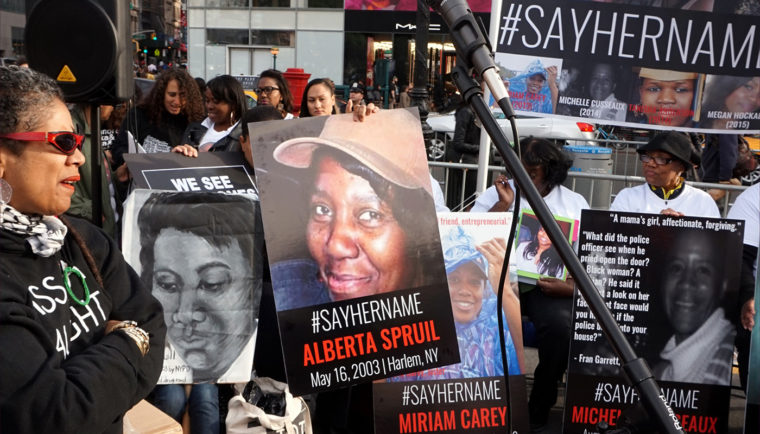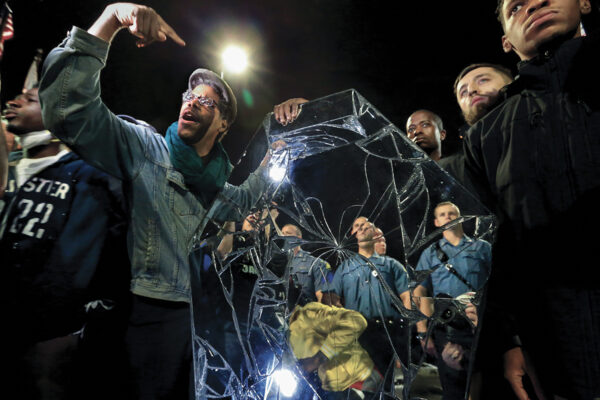Blacks, especially women, are more likely to have been unarmed when killed by police than non-blacks, and that risk appears to increase in police departments with a greater presence of non-white officers, according to a new study of nationwide data from Washington University in St. Louis.
A key finding of the study is that nearly 60 percent of black women killed by police were unarmed at the time of the interaction.
The study is the first in a series of reports from the ongoing Fatal Interactions with Police (FIPS) research project, which includes contributions from public health and biostatistics experts at hospitals and universities, including Saint Louis University, New York University and Harvard University.
While the odds of being killed by police when unarmed were about the same for black and white males, the high percentage of unarmed black women killed by police significantly increased the overall odds for unarmed blacks.
“Our analysis finds that the ‘hands up, don’t shoot’ slogan of the post-Ferguson movement becomes most relevant when you also ‘say her name,’” said lead researcher Odis Johnson, associate professor of education and of sociology, both in Arts & Sciences.

“Nonetheless, the odds of an unarmed fatality for black Americans as a whole was a staggering 6.6-to-1, more than double the odds found in several other national studies completed in recent decades.”
The “say her name” social movement was launched in 2015 to draw attention to the death of Chicago resident Rekia Boyd and other unarmed black women killed during interactions with police. This study is the first to provide hard data to back up the movement’s assertion that black women face a high risk of being killed by police.
The study also suggests that many tactics implemented to curb police violence, such as the use of body cameras and diversifying police forces by adding more non-white officers, have done little to reduce the number of people killed in police interactions.
“Agencies with more officers of color had significantly increased odds of committing unarmed fatalities, suggesting that current levels of agency diversity are not capable of achieving change,” Johnson said. “We recommend caution in interpreting this result since our data does not track the race of the police officers connected to each fatality. Thus, we are unable to say whether the actions of officers of color directly increase the odds of unarmed fatalities for racial/ethnic groups.”
The project plans to issue two more reports on related findings in coming months as it prepares to host a national symposium, titled “The Color of Policing Symposium (COPS): Youth, Education and Activism,” April 19-20 at Washington University.
The FIPS database includes details on about 1,700 fatal interactions with police that occurred in jurisdictions across the United States during a 20-month time period from May 2013 to January 2015.
It estimates the demographic odds of a fatality occurring during an interaction with police based on the location of the interaction and the characteristics of the likely responding law enforcement agency.
Other findings from the first report include:
- Nearly 94 percent of those killed by police are men; about 46 percent are white; about 22 percent had a history of drug abuse or mental illness.
- The ages of unarmed people killed by police in the database range from 5 to more than 100 years old, including people who were 101, 103 and 107.
- More than 57 percent of African American women were killed while unarmed; white males were the least likely to have been unarmed when killed at just under 20 percent.
Much more than a listing of fatal police interactions around the country, the FIPS database also contains a wealth of related demographic and law enforcement data that allows the deaths to be analyzed in the context of local conditions. Database researchers gathered background on each case through an array of public records, including media accounts, death certificates and obituaries.
In addition to U.S. Census statistics on the location where the fatality occurred, FIPS includes data about local law enforcement practices and police staffing drawn from the Law Enforcement Management and Administrative Survey (LEMAS), and crime statistics from the FBI’s Uniform Crime Reporting program.
Collected by the Bureau of Justice Statistics from about 2,800 state and local law enforcement agencies, the LEMAS data offers details on a wide range of topics: agency responsibilities, operating expenditures, job functions of sworn and civilian employees, officer salaries and special pay, demographic characteristics of officers, weapons and armor policies, education and training requirements, computers and information systems, vehicles, special units, and community policing activities.
The FIPS database project was supported by Public Health Cubed Seed Funding from the Institute of Public Health at Washington University. Other researchers involved in the project include Cassandra Arroyo-Johnson, assistant professor of surgery, Washington University School of Medicine (WUSM); Melody Goodman, interim chair the Department of Biostatistics at New York University; Marcello Pagano, professor statistical computing at Harvard T.H. Chan School of Public Health; Keon L. Gilbert, associate professor in the College of Public Health and Social Justice at Saint Louis University; Christopher St. Vil, Assistant Professor of Social Work at SUNY Buffalo; David de la Cerda, doctoral student at Wake Forest University; and Nicole Ackerman, a statistical data analyst in the WUSM Public Health Sciences Division.



